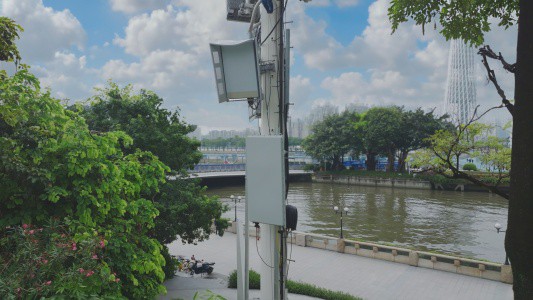ZTE, in collaboration with the Guangdong and Guangzhou branch of China Mobile, has completed the first commercial trial of a sub-6G 5G cell in the Chinese city of Guangzhou. The trial conducted using the 4.9GHz frequency band and ZTE's 128TR AAU has achieved a peak throughput of over 10Gbps.
The results show that, on a single carrier with a bandwidth of 100MHz, the cell achieved a downlink peak rate of 10.3Gbps, which is double the maximum spectrum efficiency of the existing 5G network. The uplink peak rate reached 2.8Gbps, which is 2.4 times higher than the maximum spectrum efficiency of the current 5G network.
“China Mobile and ZTE are at the forefront of implementing the 4.9GHz 128TR AAUs, pioneering the use of ultra-large-scale MIMO technology,” said ZTE in a statement released during the ongoing Mobile World Congress (MWC) Conference in Shanghai.
“This advancement will have a significant impact on the network landscape, driving the emergence of high-value scenario requirements and innovative applications. One such application is ISAC technology, which has the potential to be utilized in various verticals such as low-altitude security and smart transportation."
ZTE Corporation
The introduction of ultra-large-scale MIMO technology, with more channels and antenna elements, is a key focus area for the evolution of wireless communication technologies in 5G-Advanced and 6G.
At present, standardisation organisations and enterprises are actively researching and developing this technology. One important direction in 5G-Advanced and 6G is Integrated Sensing and Communication (ISAC), which aims to integrate higher frequency bands, including 4.9GHz, in the sub-6G spectrum. The inclusion of more transceivers enhances sensing accuracy and opens new possibilities.
Based on recent GlobalData research, global network traffic is projected to increase by 3.5 times by 2026 compared to 2022. In densely populated urban areas, the proliferation of high-traffic services necessitates enhanced network throughput and urgent capacity upgrades.
Total number of 5G users reaches 1.2 billion
Since the advent of 5G networks, the number of 5G users has surpassed 1.2 billion over the past four years, while total mobile internet traffic and average monthly user traffic (DOU) have doubled during the same time period.
The advancements in video applications have enhanced the quality of various services, with emerging technologies like 4K/8K high-resolution, VR/AR, and glasses-free 3D gaining prominence. The rapid growth of existing services and the introduction of new ones are placing higher demands on network capabilities.
Based on recent GlobalData research, global network traffic is projected to increase by 3.5 times by 2026 compared to 2022. In densely populated urban areas, the proliferation of high-traffic services necessitates enhanced network throughput and urgent capacity upgrades.
According to ZTE, the 4.9GHz band experiences higher propagation and penetration losses compared to the 2.6GHz frequency band. However, by increasing the number of antenna elements and transmission channels, the 4.9GHz band can improve its coverage and enhance indoor penetration.
“The new AAU, equipped with double the number of transceivers and antenna elements, significantly enhances its beamforming capabilities, resulting in improved cell capacity and coverage. Moreover, it ensures ample vertical coverage for high-rise buildings in densely populated urban areas,” the company said.
“The 128TR AAU, combined with enhanced software algorithms, supports up to 32 streams for downlink space division and up to 24 streams for uplink space division. It achieves a maximum beamforming gain of 3 dB, thereby enhancing deep coverage in urban areas,” it added.
In the future, the collaboration between China Mobile and ZTE will continue to play a crucial role in the development of network technologies. Their efforts will drive advancements in ultra-large-scale MIMO technology, enabling the realisation of new and transformative applications.
The integration of ISAC technology in different verticals will enhance the capabilities of wireless networks, paving the way for improved low-altitude security measures and efficient smart transportation systems.
First R17-based intelligent and green UPF launched
Meanwhile at the MWC Conference in Shanghai, ZTE and the Anhui branch of China Mobile (Anhui Mobile jointly launched the industry's first intelligent and green UPF based on R17 technology, with the aim of promoting the green transformation of networks and building green digital bases for the low-carbon development of various industries.
ZTE and Anhui Mobile have verified the commercial feasibility and energy-saving effect of intelligent and green UPFs based on the data model of the existing network. The results show that the power consumption of UPFs changes closely with the load tidal change, and the comprehensive energy consumption is reduced by more than 25%, resulting in significant energy savings.

To enhance the service experience, ZTE pointed out UPFs in the 5GC have transitioned from the centre to the edge, resulting in a substantial increase in their numbers. This causes a common challenge for operators and equipment manufacturers in implementing intelligent power-saving measures to reduce energy consumption during low-traffic periods.
ZTE and Anhui Mobile have conducted innovative research and practical experimentation to address this challenge.
“In an industry-first approach, we have leveraged the 5G intelligent engine NWDAF in collaboration with UPFs to enable intelligent energy-saving capabilities," said ZTE in a statement.
"This involves using advanced time series algorithms for model training and reasoning to accurately predict service tides and resource requirements. When the system anticipates a forthcoming low-traffic period, it automatically implements service migration, intelligent CPU frequency reduction, and core sleep without any experience impact."
ZTE Corporation
“Moreover, in scenarios with sudden bursts of service traffic, the UPF supports millisecond-level self-wake-up, enabling rapid handling of burst services with no data loss and ensuring dependable energy savings,” it added.
Moving forward, ZTE will advance research into energy-saving technologies, with the goal of helping operators build end-to-end low-carbon networks for a green and sustainable future.





